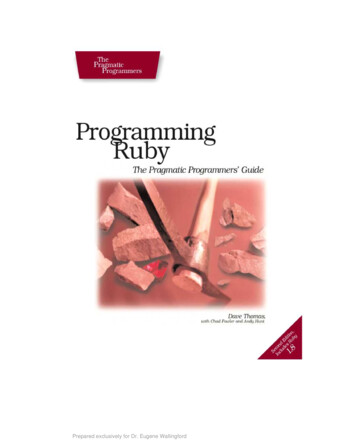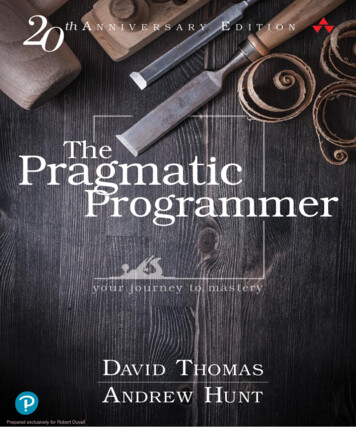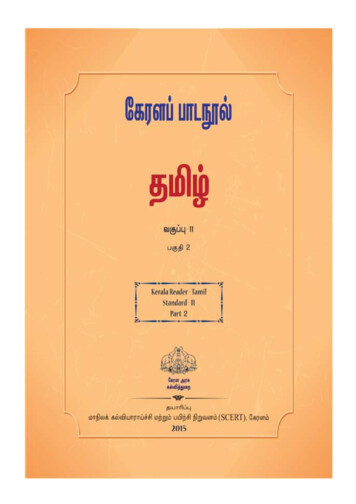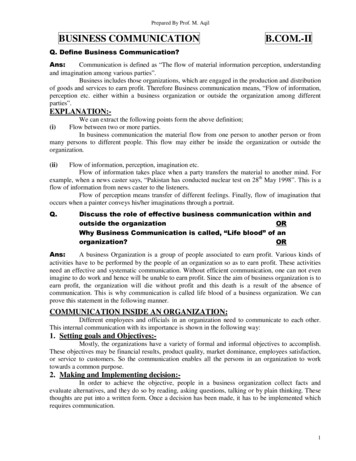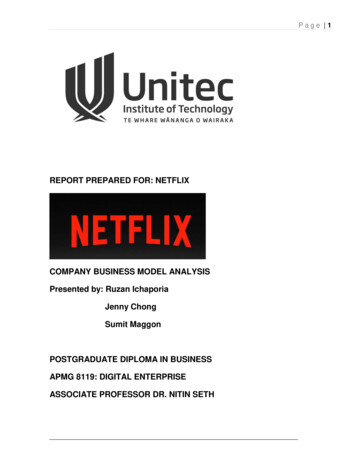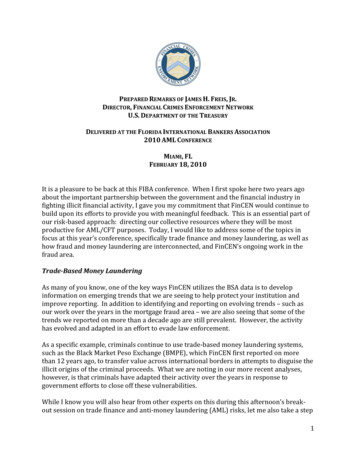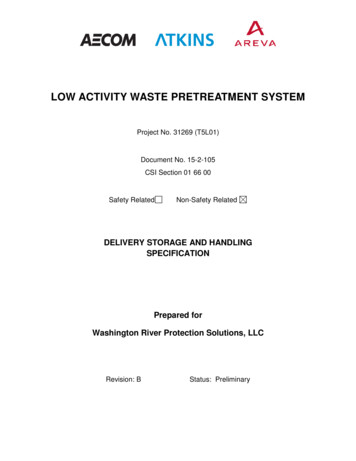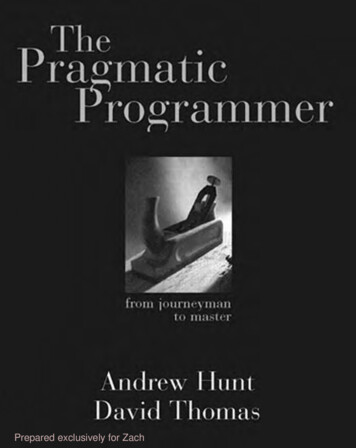
Transcription
Prepared exclusively for Zach
What others in the trenches say aboutThe Pragmatic Programmer. . .“The cool thing about this book is that it’s great for keeping theprogramming process fresh. [The book] helps you to continue to growand clearly comes from people who have been there.”Kent Beck, author of Extreme Programming Explained:Embrace Change“I found this book to be a great mix of solid advice and wonderfulanalogies!”Martin Fowler, author of Refactoring and UML Distilled“I would buy a copy, read it twice, then tell all my colleagues to runout and grab a copy. This is a book I would never loan because I wouldworry about it being lost.”Kevin Ruland, Management Science, MSG-Logistics“The wisdom and practical experience of the authors is obvious. Thetopics presented are relevant and useful. . . . By far its greateststrength for me has been the outstanding analogies—tracer bullets,broken windows, and the fabulous helicopter-based explanation of theneed for orthogonality, especially in a crisis situation. I have littledoubt that this book will eventually become an excellent source ofuseful information for journeymen programmers and expert mentorsalike.”John Lakos, author of Large-Scale C Software DesignPrepared exclusively for Zach
“This is the sort of book I will buy a dozen copies of when it comes outso I can give it to my clients.”Eric Vought, Software Engineer“Most modern books on software development fail to cover the basicsof what makes a great software developer, instead spending their timeon syntax or technology where in reality the greatest leverage possiblefor any software team is in having talented developers who really knowtheir craft well. An excellent book.”Pete McBreen, Independent Consultant“Since reading this book, I have implemented many of the practicalsuggestions and tips it contains. Across the board, they have saved mycompany time and money while helping me get my job done quicker!This should be a desktop reference for everyone who works with codefor a living.”Jared Richardson, Senior Software Developer,iRenaissance, Inc.“I would like to see this issued to every new employee at mycompany. . . .”Chris Cleeland, Senior Software Engineer,Object Computing, Inc.Prepared exclusively for Zach
The Pragmatic ProgrammerPrepared exclusively for Zach
This page intentionally left blankPrepared exclusively for Zach
The Pragmatic ProgrammerFrom Journeyman to MasterAndrew HuntDavid ThomasADDISON–WESLEYAn imprint of Addison Wesley Longman, Inc.Reading, Massachusetts Harlow, England Menlo Park, CaliforniaBerkeley, California Don Mills, Ontario SydneyBonn Amsterdam Tokyo Mexico CityPrepared exclusively for Zach
Many of the designations used by manufacturers and sellers to distinguish their productsare claimed as trademarks. Where those designations appear in this book, and Addison–Wesley was aware of a trademark claim, the designations have been printed in initialcapital letters or in all capitals.Lyrics from the song “The Boxer” on page 157 are Copyright c 1968 Paul Simon. Used bypermission of the Publisher: Paul Simon Music. Lyrics from the song “Alice’s Restaurant”on page 220 are by Arlo Guthrie, c 1966, 1967 (renewed) by A PPLESEED M USIC I NC. AllRights Reserved. Used by Permission.The authors and publisher have taken care in the preparation of this book, but makeno express or implied warranty of any kind and assume no responsibility for errors oromissions. No liability is assumed for incidental or consequential damages in connectionwith or arising out of the use of the information or programs contained herein.The publisher offers discounts on this book when ordered in quantity for special sales.For more information, please contact:AWL Direct SalesAddison Wesley Longman, Inc.One Jacob WayReading, Massachusetts 01867(781) 944-3700Visit AWL on the Web: www.awl.com/csengLibrary of Congress Cataloging-in-Publication DataHunt, Andrew, 1964 –The Pragmatic Programmer / Andrew Hunt, David Thomas.p. cm.Includes bibliographical references.ISBN 0-201-61622-X1. Computer programming.I. Thomas, David, 1956– .II. Title.QA76.6.H857 1999005.1--dc2199–43581CIPCopyright c 2000 by Addison Wesley Longman, Inc.All rights reserved. No part of this publication may be reproduced, stored in a retrievalsystem, or transmitted, in any form or by any means, electronic, mechanical, photocopying, recording, or otherwise, without the prior written permission of the publisher.Printed in the United States of America. Published simultaneously in Canada.ISBN 0-201-61622-XText printed in the United States on recycled paper at Courier Stoughton in Stoughton, Massachusetts.25th PrintingPrepared exclusively for ZachFebruary 2010
For Ellie and Juliet,Elizabeth and Zachary,Stuart and HenryPrepared exclusively for Zach
This page intentionally left blankPrepared exclusively for Zach
ContentsF OREWORDxiiiP REFACExvii1 A P RAGMATIC P HILOSOPHY11. The Cat Ate My Source Code . . . . . . . . . . . . . . . . .22. Software Entropy . . . . . . . . . . . . . . . . . . . . . . . .43. Stone Soup and Boiled Frogs . . . . . . . . . . . . . . . . .74. Good-Enough Software . . . . . . . . . . . . . . . . . . . .95. Your Knowledge Portfolio . . . . . . . . . . . . . . . . . . .126. Communicate! . . . . . . . . . . . . . . . . . . . . . . . . .182 A P RAGMATIC A PPROACH257. The Evils of Duplication . . . . . . . . . . . . . . . . . . . .268. Orthogonality . . . . . . . . . . . . . . . . . . . . . . . . . .349. Reversibility . . . . . . . . . . . . . . . . . . . . . . . . . . .4410. Tracer Bullets. . . . . . . . . . . . . . . . . . . . . . . . .4811. Prototypes and Post-it Notes . . . . . . . . . . . . . . . . .5312. Domain Languages. . . . . . . . . . . . . . . . . . . . . .5713. Estimating . . . . . . . . . . . . . . . . . . . . . . . . . . .643 T HE B ASIC T OOLS7114. The Power of Plain Text . . . . . . . . . . . . . . . . . . . .7315. Shell Games . . . . . . . . . . . . . . . . . . . . . . . . . .7716. Power Editing . . . . . . . . . . . . . . . . . . . . . . . . . .8217. Source Code Control . . . . . . . . . . . . . . . . . . . . . .8618. Debugging . . . . . . . . . . . . . . . . . . . . . . . . . . . .9019. Text Manipulation . . . . . . . . . . . . . . . . . . . . . . .9920. Code Generators . . . . . . . . . . . . . . . . . . . . . . . . 102ixPrepared exclusively for Zach
xC ONTENTS4 P RAGMATIC PARANOIA10721. Design by Contract . . . . . . . . . . . . . . . . . . . . . . 10922. Dead Programs Tell No Lies. . . . . . . . . . . . . . . . . 12023. Assertive Programming . . . . . . . . . . . . . . . . . . . . 12224. When to Use Exceptions . . . . . . . . . . . . . . . . . . . 12525. How to Balance Resources . . . . . . . . . . . . . . . . . . 1295 B END ,ORB REAK13726. Decoupling and the Law of Demeter . . . . . . . . . . . . . 13827. Metaprogramming . . . . . . . . . . . . . . . . . . . . . . . 14428. Temporal Coupling . . . . . . . . . . . . . . . . . . . . . . . 15029. It’s Just a View . . . . . . . . . . . . . . . . . . . . . . . . . 15730. Blackboards. . . . . . . . . . . . . . . . . . . . . . . . . . 1656 W HILE Y OU A RE C ODING31. Programming by Coincidence171. . . . . . . . . . . . . . . . 17232. Algorithm Speed . . . . . . . . . . . . . . . . . . . . . . . . 17733. Refactoring . . . . . . . . . . . . . . . . . . . . . . . . . . . 18434. Code That’s Easy to Test . . . . . . . . . . . . . . . . . . . 18935. Evil Wizards7 B EFORETHE. . . . . . . . . . . . . . . . . . . . . . . . . . 198P ROJECT20136. The Requirements Pit . . . . . . . . . . . . . . . . . . . . . 20237. Solving Impossible Puzzles . . . . . . . . . . . . . . . . . . 21238. Not Until You’re Ready . . . . . . . . . . . . . . . . . . . . 21539. The Specification Trap. . . . . . . . . . . . . . . . . . . . 21740. Circles and Arrows . . . . . . . . . . . . . . . . . . . . . . . 2208 P RAGMATIC P ROJECTS22341. Pragmatic Teams . . . . . . . . . . . . . . . . . . . . . . . . 22442. Ubiquitous Automation . . . . . . . . . . . . . . . . . . . . 23043. Ruthless Testing . . . . . . . . . . . . . . . . . . . . . . . . 23744. It’s All Writing . . . . . . . . . . . . . . . . . . . . . . . . . 24845. Great Expectations. . . . . . . . . . . . . . . . . . . . . . 25546. Pride and Prejudice . . . . . . . . . . . . . . . . . . . . . . 258Prepared exclusively for Zach
C ONTENTSxiAppendicesA R ESOURCES261Professional Societies . . . . . . . . . . . . . . . . . . . . . . . . 262Building a Library . . . . . . . . . . . . . . . . . . . . . . . . . . 262Internet Resources . . . . . . . . . . . . . . . . . . . . . . . . . 266Bibliography . . . . . . . . . . . . . . . . . . . . . . . . . . . . . 275B A NSWERSI NDEXPrepared exclusively for ZachTOE XERCISES279309
This page intentionally left blankPrepared exclusively for Zach
ForewordAs a reviewer I got an early opportunity to read the book you are holding. It was great, even in draft form. Dave Thomas and Andy Hunt havesomething to say, and they know how to say it. I saw what they weredoing and I knew it would work. I asked to write this foreword so that Icould explain why.Simply put, this book tells you how to program in a way that you canfollow. You wouldn’t think that that would be a hard thing to do, but itis. Why? For one thing, not all programming books are written by programmers. Many are compiled by language designers, or the journalistswho work with them to promote their creations. Those books tell youhow to talk in a programming language—which is certainly important,but that is only a small part of what a programmer does.What does a programmer do besides talk in programming language?Well, that is a deeper issue. Most programmers would have troubleexplaining what they do. Programming is a job filled with details, andkeeping track of those details requires focus. Hours drift by and thecode appears. You look up and there are all of those statements. If youdon’t think carefully, you might think that programming is just typingstatements in a programming language. You would be wrong, of course,but you wouldn’t be able to tell by looking around the programmingsection of the bookstore.In The Pragmatic Programmer Dave and Andy tell us how to program ina way that we can follow. How did they get so smart? Aren’t they justas focused on details as other programmers? The answer is that theypaid attention to what they were doing while they were doing it—andthen they tried to do it better.Imagine that you are sitting in a meeting. Maybe you are thinkingthat the meeting could go on forever and that you would rather beprogramming. Dave and Andy would be thinking about why they werexiiiPrepared exclusively for Zach
xivF OREWORDhaving the meeting, and wondering if there is something else they coulddo that would take the place of the meeting, and deciding if that something could be automated so that the work of the meeting just happensin the future. Then they would do it.That is just the way Dave and Andy think. That meeting wasn’t something keeping them from programming. It was programming. And itwas programming that could be improved. I know they think this waybecause it is tip number two: Think About Your Work.So imagine that these guys are thinking this way for a few years.Pretty soon they would have a collection of solutions. Now imaginethem using their solutions in their work for a few more years, anddiscarding the ones that are too hard or don’t always produce results.Well, that approach just about defines pragmatic. Now imagine themtaking a year or two more to write their solutions down. You mightthink, That information would be a gold mine. And you would be right.The authors tell us how they program. And they tell us in a way that wecan follow. But there is more to this second statement than you mightthink. Let me explain.The authors have been careful to avoid proposing a theory of softwaredevelopment. This is fortunate, because if they had they would beobliged to warp each chapter to defend their theory. Such warping isthe tradition in, say, the physical sciences, where theories eventuallybecome laws or are quietly discarded. Programming on the other handhas few (if any) laws. So programming advice shaped around wanna-belaws may sound good in writing, but it fails to satisfy in practice. Thisis what goes wrong with so many methodology books.I’ve studied this problem for a dozen years and found the most promisein a device called a pattern language. In short, a pattern is a solution,and a pattern language is a system of solutions that reinforce eachother. A whole community has formed around the search for thesesystems.This book is more than a collection of tips. It is a pattern languagein sheep’s clothing. I say that because each tip is drawn from experience, told as concrete advice, and related to others to form a system.These are the characteristics that allow us to learn and follow a patternlanguage. They work the same way here.Prepared exclusively for Zach
F OREWORDxvYou can follow the advice in this book because it is concrete. You won’tfind vague abstractions. Dave and Andy write directly for you, as if eachtip was a vital strategy for energizing your programming career. Theymake it simple, they tell a story, they use a light touch, and then theyfollow that up with answers to questions that will come up when youtry.And there is more. After you read ten or fifteen tips you will begin to seean extra dimension to the work. We sometimes call it QWAN, short forthe quality without a name. The book has a philosophy that will oozeinto your consciousness and mix with your own. It doesn’t preach. Itjust tells what works. But in the telling more comes through. That’s thebeauty of the book: It embodies its philosophy, and it does so unpretentiously.So here it is: an easy to read—and use—book about the whole practiceof programming. I’ve gone on and on about why it works. You probablyonly care that it does work. It does. You will see.—Ward CunninghamPrepared exclusively for Zach
This page intentionally left blankPrepared exclusively for Zach
PrefaceThis book will help you become a better programmer.It doesn’t matter whether you are a lone developer, a member of a largeproject team, or a consultant working with many clients at once. Thisbook will help you, as an individual, to do better work. This book isn’ttheoretical—we concentrate on practical topics, on using your experience to make more informed decisions. The word pragmatic comes fromthe Latin pragmaticus—“skilled in business”—which itself is derivedfrom the Greek, meaning “to do.” This is a book about doing.Programming is a craft. At its simplest, it comes down to getting acomputer to do what you want it to do (or what your user wants it to do).As a programmer, you are part listener, part advisor, part interpreter,and part dictator. You try to capture elusive requirements and find away of expressing them so that a mere machine can do them justice.You try to document your work so that others can understand it, andyou try to engineer your work so that others can build on it. What’smore, you try to do all this against the relentless ticking of the projectclock. You work small miracles every day.It’s a difficult job.There are many people offering you help. Tool vendors tout the miracles their products perform. Methodology gurus promise that theirtechniques guarantee results. Everyone claims that their programminglanguage is the best, and every operating system is the answer to allconceivable ills.Of course, none of this is true. There are no easy answers. There is nosuch thing as a best solution, be it a tool, a language, or an operating system. There can only be systems that are more appropriate in aparticular set of circumstances.xviiPrepared exclusively for Zach
xviiiP REFACEThis is where pragmatism comes in. You shouldn’t be wedded to anyparticular technology, but have a broad enough background and experience base to allow you to choose good solutions in particular situations. Your background stems from an understanding of the basicprinciples of computer science, and your experience comes from a widerange of practical projects. Theory and practice combine to make youstrong.You adjust your approach to suit the current circumstances and environment. You judge the relative importance of all the factors affecting aproject and use your experience to produce appropriate solutions. Andyou do this continuously as the work progresses. Pragmatic Programmers get the job done, and do it well.Who Should Read This Book?This book is aimed at people who want to become more effective andmore productive programmers. Perhaps you feel frustrated that youdon’t seem to be achieving your potential. Perhaps you look at colleagues who seem to be using tools to make themselves more productive than you. Maybe your current job uses older technologies, and youwant to know how newer ideas can be applied to what you do.We don’t pretend to have all (or even most) of the answers, nor areall of our ideas applicable in all situations. All we can say is that ifyou follow our approach, you’ll gain experience rapidly, your productivity will increase, and you’ll have a better understanding of the entiredevelopment process. And you’ll write better software.What Makes a Pragmatic Programmer?Each developer is unique, with individual strengths and weaknesses,preferences and dislikes. Over time, each will craft his or her ownpersonal environment. That environment will reflect the programmer’sindividuality just as forcefully as his or her hobbies, clothing, or haircut. However, if you’re a Pragmatic Programmer, you’ll share many ofthe following characteristics:Early adopter/fast adapter. You have an instinct for technologiesand techniques, and you love trying things out. When given some-Prepared exclusively for Zach
P REFACExixthing new, you can grasp it quickly and integrate it with the rest ofyour knowledge. Your confidence is born of experience.Inquisitive. You tend to ask questions. That’s neat—how did youdo that? Did you have problems with that library? What’s this BeOSI’ve heard about? How are symbolic links implemented? You are apack rat for little facts, each of which may affect some decisionyears from now.Critical thinker. You rarely take things as given without first getting the facts. When colleagues say “because that’s the way it’sdone,” or a vendor promises the solution to all your problems, yousmell a challenge.Realistic. You try to understand the underlying nature of eachproblem you face. This realism gives you a good feel for how difficult things are, and how long things will take. Understanding foryourself that a process should be difficult or will take a while tocomplete gives you the stamina to keep at it.Jack of all trades. You try hard to be familiar with a broad rangeof technologies and environments, and you work to keep abreast ofnew developments. Although your current job may require you tobe a specialist, you will always be able to move on to new areas andnew challenges.We’ve left the most basic characteristics until last. All Pragmatic Programmers share them. They’re basic enough to state as tips:TIP 1Care About Your CraftWe feel that there is no point in developing software unless you careabout doing it well.TIP 2Think! About Your WorkIn order to be a Pragmatic Programmer, we’re challenging you to thinkabout what you’re doing while you’re doing it. This isn’t a one-timeaudit of current practices—it’s an ongoing critical appraisal of everyPrepared exclusively for Zach
xxP REFACEdecision you make, every day, and on every development. Never run onauto-pilot. Constantly be thinking, critiquing your work in real time.The old IBM corporate motto, THINK!, is the Pragmatic Programmer’smantra.If this sounds like hard work to you, then you’re exhibiting the realisticcharacteristic. This is going to take up some of your valuable time—timethat is probably already under tremendous pressure. The reward is amore active involvement with a job you love, a feeling of mastery overan increasing range of subjects, and pleasure in a feeling of continuousimprovement. Over the long term, your time investment will be repaidas you and your team become more efficient, write code that’s easier tomaintain, and spend less time in meetings.Individual Pragmatists, Large TeamsSome people feel that there is no room for individuality on large teamsor complex projects. “Software construction is an engineering discipline,” they say, “that breaks down if individual team members makedecisions for themselves.”We disagree.The construction of software should be an engineering discipline. However, this doesn’t preclude individual craftsmanship. Think about thelarge cathedrals built in Europe during the Middle Ages. Each tookthousands of person-years of effort, spread over many decades. Lessonslearned were passed down to the next set of builders, who advancedthe state of structural engineering with their accomplishments. But thecarpenters, stonecutters, carvers, and glass workers were all craftspeople, interpreting the engineering requirements to produce a whole thattranscended the purely mechanical side of the construction. It was theirbelief in their individual contributions that sustained the projects:We who cut mere stones must always be envisioning cathedrals.— Quarry worker’s creedWithin the overall structure of a project there is always room for individuality and craftsmanship. This is particularly true given the current state of software engineering. One hundred years from now, ourengineering may seem as archaic as the techniques used by medievalPrepared exclusively for Zach
P REFACExxicathedral builders seem to today’s civil engineers, while our craftsmanship will still be honored.It’s a Continuous ProcessA tourist visiting England’s Eton College asked the gardener how he gotthe lawns so perfect. “That’s easy,” he replied, “You just brush off thedew every morning, mow them every other day, and roll them once aweek.”“Is that all?” asked the tourist.“Absolutely,” replied the gardener. “Do that for 500 years and you’llhave a nice lawn, too.”Great lawns need small amounts of daily care, and so do great programmers. Management consultants like to drop the word kaizen inconversations. “Kaizen” is a Japanese term that captures the conceptof continuously making many small improvements. It was consideredto be one of the main reasons for the dramatic gains in productivity andquality in Japanese manufacturing and was widely copied throughoutthe world. Kaizen applies to individuals, too. Every day, work to refinethe skills you have and to add new tools to your repertoire. Unlike theEton lawns, you’ll start seeing results in a matter of days. Over theyears, you’ll be amazed at how your experience has blossomed andyour skills have grown.How the Book Is OrganizedThis book is written as a collection of short sections. Each section isself-contained, and addresses a particular topic. You’ll find numerouscross references, which help put each topic in context. Feel free to readthe sections in any order—this isn’t a book you need to read front-toback.Occasionally you’ll come across a box labeled Tip nn (such as Tip 1,“Care About Your Craft” on page xix). As well as emphasizing points inthe text, we feel the tips have a life of their own—we live by them daily.You’ll find a summary of all the tips on a pull-out card inside the backcover.Prepared exclusively for Zach
xxiiP REFACEAppendix A contains a set of resources: the book’s bibliography, a list ofURLs to Web resources, and a list of recommended periodicals, books,and professional organizations. Throughout the book you’ll find references to the bibliography and to the list of URLs—such as [KP99] and[URL 18], respectively.We’ve included exercises and challenges where appropriate. Exercisesnormally have relatively straightforward answers, while the challengesare more open-ended. To give you an idea of our thinking, we’ve included our answers to the exercises in Appendix B, but very few havea single correct solution. The challenges might form the basis of groupdiscussions or essay work in advanced programming courses.What’s in a Name?“When I use a word,” Humpty Dumpty said, in rather a scornful tone, “it meansjust what I choose it to mean—neither more nor less.”Lewis Carroll, Through the Looking-GlassScattered throughout the book you’ll find various bits of jargon—eitherperfectly good English words that have been corrupted to mean something technical, or horrendous made-up words that have been assignedmeanings by computer scientists with a grudge against the language.The first time we use each of these jargon words, we try to define it,or at least give a hint to its meaning. However, we’re sure that somehave fallen through the cracks, and others, such as object and relational database, are in common enough usage that adding a definitionwould be boring. If you do come across a term you haven’t seen before, please don’t just skip over it. Take time to look it up, perhaps onthe Web, or maybe in a computer science textbook. And, if you get achance, drop us an e-mail and complain, so we can add a definition tothe next edition.Having said all this, we decided to get revenge against the computer scientists. Sometimes, there are perfectly good jargon words for concepts,words that we’ve decided to ignore. Why? Because the existing jargonis normally restricted to a particular problem domain, or to a particular phase of development. However, one of the basic philosophies ofthis book is that most of the techniques we’re recommending are universal: modularity applies to code, designs, documentation, and teamPrepared exclusively for Zach
P REFACExxiiiorganization, for instance. When we wanted to use the conventionaljargon word in a broader context, it got confusing—we couldn’t seemto overcome the baggage the original term brought with it. When thishappened, we contributed to the decline of the language by inventingour own terms.Source Code and Other ResourcesMost of the code shown in this book is extracted from compilable sourcefiles, available for download from our Web site:www.pragmaticprogrammer.comThere you’ll also find links to resources we find useful, along withupdates to the book and news of other Pragmatic Programmer developments.Send Us FeedbackWe’d appreciate hearing from you. Comments, suggestions, errors inthe text, and problems in the examples are all welcome. E-mail us n we started writing this book, we had no idea how much of a teameffort it would end up being.Addison-Wesley has been brilliant, taking a couple of wet-behind-theears hackers and walking us through the whole book-production process, from idea to camera-ready copy. Many thanks to John Waitand Meera Ravindiran for their initial support, Mike Hendrickson, ourenthusiastic editor (and a mean cover designer!), Lorraine Ferrier andJohn Fuller for their help with production, and the indefatigable JulieDeBaggis for keeping us all together.Then there were the reviewers: Greg Andress, Mark Cheers, Chris Cleeland, Alistair Cockburn, Ward Cunningham, Martin Fowler, ThanhT. Giang, Robert L. Glass, Scott Henninger, Michael Hunter, BrianPrepared exclusively for Zach
xxivP REFACEKirby, John Lakos, Pete McBreen, Carey P. Morris, Jared Richardson,Kevin Ruland, Eric Starr, Eric Vought, Chris Van Wyk, and DeborraZukowski. Without their careful comments and valuable insights, thisbook would be less readable, less accurate, and twice as long. Thankyou all for your time and wisdom.The second printing of this book benefited greatly from the eagle eyesof our readers. Many thanks to Brian Blank, Paul Boal, Tom Ekberg,Brent Fulgham, Louis Paul Hebert, Henk-Jan Olde Loohuis, Alan Lund,Gareth McCaughan, Yoshiki Shibata, and Volker Wurst, both for finding the mistakes and for having the grace to point them out gently.Over the years, we have worked with a large number of progressiveclients, where we gained and refined the experience we write abouthere. Recently, we’ve been fortunate to work with Peter Gehrke on several large projects. His support and enthusiasm for our techniques aremuch appreciated.This book was produced using LATEX, pic, Perl, dvips, ghostview, ispell,GNU make, CVS, Emacs, XEmacs, EGCS, GCC, Java, iContract, andSmallEiffel, using the Bash and zsh shells under Linux. The staggering thing is that all of this tremendous software is freely available. Weowe a huge “thank you” to the thousands of Pragmatic Programmersworldwide who have contributed these and other works to us all. We’dparticularly like to thank Reto Kramer for his help with iContract.Last, but in no way least, we owe a huge debt to our families. Not onlyhave they put up with late night typing, huge telephone bills, and ourpermanent air of distraction, but they’ve had the grace to read whatwe’ve written, time after time. Thank you for letting us dream.Andy HuntDave ThomasPrepared exclusively for Zach
Chapter 1A Pragmatic PhilosophyWhat distinguishes Pragmatic Programmers? We feel it’s an attitude, astyle, a philosophy of approaching problems and their solutions. Theythink beyond the immediate problem, always trying to place it in itslarger context, always trying to be aware of the bigger picture. After all,without this larger context, how can you be pragmatic? How can youmake intelligent compromises and informed decisions?Another key to their success is that they take responsibility for everything they do, which we discuss in The Cat Ate My Source Code. Beingresponsible, Pragmatic Programmers won’t sit idly by and watch theirprojects fall apart through neglect. In Software Entropy, we tell you howto keep your projects pristine.Most people find change difficult to accept, sometimes for good reasons,sometimes because of plain old inertia. In Stone Soup and Boiled Frogs,we look at a strategy for instigating
The Pragmatic Programmer From Journeyman to Master Andrew Hunt David Thomas ADDISON–WESLEY An imprint of Addison Wesley Longman, Inc. Reading, Massachusetts Harlow, England Menlo Park, California Berkeley, California Don Mills, Ontario Sydney Bonn
